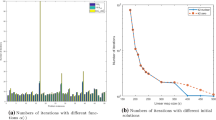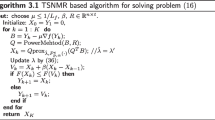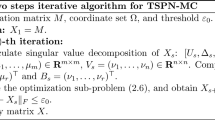Abstract
Low-rank matrix recovery aims to recover a matrix of minimum rank that subject to linear system constraint. It arises in various real world applications, such as recommender systems, image processing, and deep learning. Inspired by compressive sensing, the rank minimization can be relaxed to nuclear norm minimization. However, such a method treats all singular values of target matrix equally. To address this issue, recently the transformed Schatten-1 (TS1) penalty function was proposed and utilized to construct low-rank matrix recovery models. Unfortunately, the method for TS1-based models cannot provide both convergence accuracy and convergence speed. To alleviate such problems, this paper further investigates the basic properties of TS1 penalty function. And we describe a novel algorithm, which we called ATS1PGA, that is highly efficient in solving low-rank matrix recovery problems at a convergence rate of O(1/N), where N denotes the iterate count. In addition, we theoretically prove that the original rank minimization problem can be equivalently transformed into the TS1 optimization problem under certain conditions. Finally, extensive experimental results on real image data sets show that our proposed algorithm outperforms state-of-the-art methods in both accuracy and efficiency. In particular, our proposed algorithm is about 30 times faster than TS1 algorithm in solving low-rank matrix recovery problems.






Similar content being viewed by others
References
Koren Y (2008) Factorization meets the neighborhood: a multifaceted collaborative filtering model. In: Proceedings of the 14th ACM SIGKDD international conference on knowledge discovery and data mining, pp 426–434
Luo X, Zhou M, Li S, You Z, Xia Y, Zhu Q (2016) A non-negative latent factor model for large-scale sparse matrices in recommender systems via alternating direction method. IEEE Trans Neural Netw Learn Syst 27(3):579–592
Huang C, Ding X, Fang C, Wen D (2014) Robust image restoration via adaptive low-rank approximation and joint kernel regression. IEEE Trans Image Process 23(12):5284–5297
Chen B, Yang Z, Yang Z (2018) An algorithm for low-rank matrix factorization and its applications. Neurocomputing 275:1012–1020
Zhao F, Peng J, Cui A (2020) Design strategy of thresholding operator for low-rank matrix recovery problem. Signal Process 171:1–10
Luo X, Zhou M, Li S, Xia Y, You Z, Zhu Q, Leung H (2018) Incorporation of efficient second-order solvers into latent factor models for accurate prediction of missing QoS data. IEEE Trans Cybern 48(4):1216–1228
Fan J, Chow T (2017) Deep learning based matrix completion. Neurocomputing 266:791–803
Peng X, Zhang Y, Tang H (2016) A unified framework for representation-based subspace clustering of out-of-sample and large-scale data. IEEE Trans Neural Netw Learn Syst 27(12):2499–2512
Liu G, Liu Q, Yuan X (2017) A new theory for matrix completion. In: Proceedings of the advances in neural information processing systems, pp 785–794
Liu G, Liu Q, Li P (2016) Low-rank matrix completion in the presence of high coherence. IEEE Trans Signal Process 64(21):5623–5633
Fazel M (2002) Matrix rank minimization with applications. Ph.D. thesis, Stanford University
Recht B, Fazel M, Parrilo P (2010) Guaranteed minimum-rank solutions of linear matrix equations via nuclear norm minimization. SIAM Rev 52(3):471–501
Cai J-F, Candès EJ, Shen Z (2010) A singular value thresholding algorithm for matrix completion. SIAM J Optim 20(4):1956–1982
Toh K-C, Yun S (2010) An accelerated proximal gradient algorithm for nuclear norm regularized linear least squares problems. Pac. J Optim 6(3):615–640
Yao Q, Kwok J (2015) Accelerated inexact soft-impute for fast large scale matrix completion. In: Proceedings of the international joint conference on artificial intelligence, pp 4002–4008
Wang Z, Wang W, Wang J, Chen S (2019) Fast and efficient algorithm for matrix completion via closed-form 2/3-thresholding operator. Neurocomputing 330:212–222
Wang Z, Gao C, Luo X, Tang M, Wang J, Chen W (2020) Accelerated inexact matrix completion algorithm via closed-form q-thresholding \((q=1/2,2/3)\) operator. Int J Mach Learn Cybern 11:2327–2339
Wang Z, Liu Y, Luo X, Wang J, Gao C, Peng D, Chen W (2021) Large-scale affine matrix rank minimization with a novel nonconvex regularizer. IEEE Trans Neural Netw Learn Syst (to be published)
Gu S, Zhang L, Zuo W, Feng X (2014) Weighted nuclear norm minimization with application to image denoising. In: Proceedings of the IEEE conference on computer vision and pattern recognition, pp 2862–2869
Fan J, Li R (2001) Variable selection via nonconcal penalized likelihood and its oracle properties. J Am Stat Assoc 96(456):1348–1360
Zhang C (2010) Nearly unbiased variable selection under minimax concave penalty. Ann Stat 38(2):894–942
Candès EJ, Wakin M, Boyd S (2008) Enhancing sparsity by reweighted \(l_{1}\) minimization. J Fourier Anal Appl 14:877–905
Peng D, Xiu N, Yu J (2017) \(S_{1/2}\) regularization methods and fixed point algorithms for affine rank minimization problems. Comput Optim Appl 67:543–569
Lu C, Tang J, Yan S, Lin Z (2016) Nonconvex nonsmooth low rank minimization via iteratively reweighted nuclear norm. IEEE Trans Image Process 25(1):829–839
Yao Q, Kwok J, Wang T, Liu T (2019) Large-scale low-rank matrix learning with nonconvex regularizers. IEEE Trans Pattern Anal Mach Intell 41(11):2628–2643
Zhang S, Yin P, Xin J (2017) Transformed Schatten-1 iterative thresholding algorithms for low rank matrix completion. Commun Math Sci 15(3):839–862
Lv J, Fan Y (2009) A unified approach to model selection and sparse recovery using regularized least squares. Ann Stat 37(6):3498–3528
Kang Z, Peng C, Cheng Q (2015) Robust PCA via nonconvex rank approximation. In: Proceedings of IEEE international conference on data mining, pp 211–220
Zhang S, Xin J (2017) Minimization of transformed \(L_{1}\) penalty: closed form representation and iterative thresholding algorithms. Commun Math Sci 15(2):511–537
Zhang S, Xin J (2018) Minimization of transformed \(L_{1}\) penalty: theory, difference of convex function algorithm, and robust application in compressed sensing. Math Progr 169(1–2):307–336
Cui A, Peng J, Li H (2018) Exact recovery low-rank matrix via transformed affine matrix rank minimization. Neurocomputing 319:1–12
Parikh N, Boyd S (2014) Proximal algorithms. Found Trends Optim 1(3):127–239
Schmidt M, Roux N, Bach F (2011) Convergence rates of inexact proximal gradient methods for convex optimization. In: Proceedings of the advances in neural information processing systems, pp 1458–1466
Gu B, Huo Z, Huang H (2018) Inexact proximal gradient methods for non-convex and non-smooth optimization. In: Proceedings of the twenty-second AAAI conference on artificial intelligence, pp 3093–3100
Li H, Lin Z (2015) Accelerated proximal gradient methods for nonconvex programming. In: Proceedings of the advances in neural information processing systems, pp 379–387
Wang Z, Lai M, Lu Z, Fan W, Davulcu H, Ye J (2015) Orthogonal rank-one matrix pursuit for low rank matrix completion. SIAM J Sci Comput 37(1):A488–A514
Halko N, Martinsson P, Tropp J (2011) Finding structure with randomness: Probabilistic algorithms for constructing approximate matrix decompositions. SIAM Rev 53(2):217–288
Oh T, Matsushita Y, Tai Y, Kweon I (2018) Fast randomized singular value thresholding for low-rank optimization. IEEE Trans Pattern Anal Mach Intell 40(2):376–391
Nesterov Y (1983) A method for solving the convex programming problem with convergence rate \(O(1/k^{2})\). Dokl Akad Nauk SSSR 27(2):543–547
Li Q, Zhou Y, Liang Y, Varshney P (2017) Convergence analysis of proximal gradient with momentum for nonconvex optimization. In: Proceedings of the 34th international conference on machine learning, pp 2111–2119
Ma S, Goldfarb D, Chen L (2011) Fixed point and Bregman iterative methods for matrix rank minimization. Math Progr 128(1–2):321–353
Thu Q, Ghanbari M (2008) Scope of validity of PSNR in image/video quality assessment. Electron Lett 44(13):800–801
Acknowledgements
This work is supported in part by the Natural Science Foundation of China under Grant 11901476, and in part by the Fundamental Research Funds for the Central Universities under Grant SWU120036.
Author information
Authors and Affiliations
Corresponding authors
Additional information
Publisher's Note
Springer Nature remains neutral with regard to jurisdictional claims in published maps and institutional affiliations.
Rights and permissions
About this article
Cite this article
Wang, Z., Hu, D., Luo, X. et al. Performance guarantees of transformed Schatten-1 regularization for exact low-rank matrix recovery. Int. J. Mach. Learn. & Cyber. 12, 3379–3395 (2021). https://doi.org/10.1007/s13042-021-01361-1
Received:
Accepted:
Published:
Issue Date:
DOI: https://doi.org/10.1007/s13042-021-01361-1




